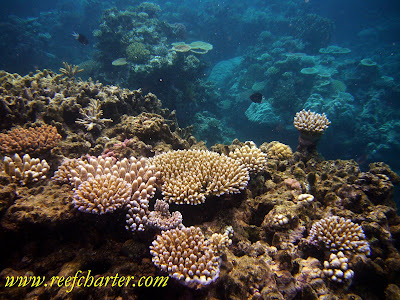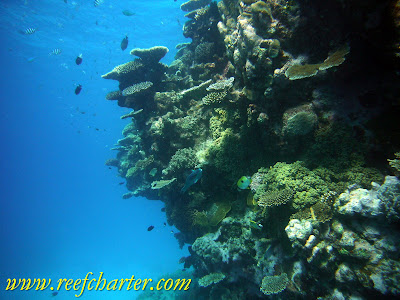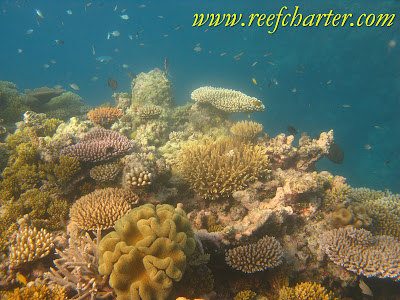We even have a picture with labels today, don’t get used to it. This is courtesy of Fiona please see the credits below.
A coral reef is an accumulation of the limestone skeletons of dead reef organisms and the algae that glues them together.
The coral reef builds upwards, growing towards the light much like trees in a rainforest, competing for space and light. Once the coral reef reaches sea level it cannot survive the harsh surface conditions so begins to grow outwards. Creating spectacular formations of coral that spawn further growth and spreading of the reef ecosystem.
Through time, animals grow and the sand, rubble and debris of life is broken down by waves and eroding animals, such as worms and sponges. A complex reef ecosystem is built over time. Today’s underwater gullies and caves were formed because of that erosion. These are the same formations scuba divers enjoy exploring today because they are shelters for an abundance of marine life.
Coral reefs tend to grow where there is a lot of water movement, bringing nutrients, oxygen and new species. Most reef-building corals cannot grow in waters shallow enough to expose them at high tide or deeper than 50 metres, making them highly sensitive to changing sea levels.
The Reef is continually evolving and changing as climate and sea levels change. Healthy, diverse reef ecosystems are more resilient, that is, they are able to adapt to change. The Great Barrier Reef Marine Park Authority is concentrating on maximising reef resilience through research and management.
Thanks to Fiona Merida for this great information. Fiona currently runs the Eye on the Reef Program for the Great Barrier Marine Park Authority. A very successful program that brings together and unites the Great Barrier Reef Marine Park Authority, the Great Barrier Reef tourism industry and the reef research community for the greater good of protecting the reef and educating the community.
Category: Great Barrier Reef Facts
A Brief History of the Great Barrier Reef
A lot of our readers have asked for a brief history and background on coral reef formations. I’ll try not to bore everyone. Believe me it makes a better discussion when we are sailing or diving on the reef. The Great Barrier Reef is that like every other ecosystem in world. It’s life-cycle is far greater then man’s living history and we are only just starting to understand this complex underwater world. Most research only dates back 30 years and many data points are close to shore and don’t cover the full extent, depths and variety of coral reefs.
As far as the history of the world goes, reefs appear to be a fairly new phenomenon, only one million years old, a bit older than all of us. The earliest signs of the Great Barrier Reef appeared just over 500,000 years old. Just some background here that a lot of people are unaware of, regardless of what the press etc have been reporting, seas rise and fall naturally and have been doing so since time began. During the rising phase, without human interaction, seas rise about 10m every thousand years. Over the last 500,000 years we have undergone the rise and fall of oceans just under 20 times. The current Great Barrier Reef started growing between 6 and 9,000 years ago, that is when sea levels rose over old underlying reefs and corals started growing. Sleepy yet?
So when the sea level rises the coral reefs take full advantage and often the grow faster then the sea level rises. The coral keeps growing towards the surface, like a plant towards the sun, until the reef flat is exposed at low tides (sea level). When the coral reefs reach the surface, the growth stops or slows and the battle between mother nature and the reef continues. Strong winds, storms, predators, the summer heat, as well as numerous other factors are continually impacting the reef.
So how does the reef survive this continual attack? Well, corals have evolved over thousands of years to survive this delicate ecosystem. So a couple of things:
-When coral spawns it can only successfully seed and grow if the spot it comes to rest on is clean. That means no algae or live coral. So all the damage above actually makes way for the next generation of corals.
– These cycles are natural and the Great Barrier Reef has survived these impacts for hundreds of thousands of years.
– We know from core samples taken around the world that reefs are very resilient to natural events. Only a few species have become extinct over the last 100,000 years.
– Different types of corals grow at different rates so reefs have the ability to reclaim themselves very quickly and then diversify over time as long as there is “seed” coral remaining or another reef nearby.
Coral Reefs build up slowly towards the surface, building upon the growth of previous generations as well as dead coral caused by the impacts above. This is how snorkellers and divers get to enjoy the reefs everyday around the world. By minimizing our impact on the reef we can make sure that this cycle continues.
-Follow reef safe diving and snorkeling practices.
-Reducing major pollutants that have impact on coral growth to ensure that we do not wipe out entire reef systems.
Comparing samples from older reefs to the newer reefs we see that much more damage is happening with much more frequency and to date most reefs have proven resilient. Reefs closer to major human population centres have suffered the most impact. As long as we minimize our impacts, we can be pretty sure that these amazing ecosystems will continue to inspire generations to come.
Facts About Coral Reefs
Quick and Fast Facts
• The Great Barrier Reef is the largest structure built by living organisms on the Earth today.
• The Great Barrier Reef region is the world’s largest group of coral reefs.
• There are three main types of reefs found on the Great Barrier Reef: Ribbon, Platform, and Fringing reefs.
• Tiny masses of coral polyps are responsible for building coral reefs.
• Coral Reefs make up 6% of the entire Great Barrier Reef Marine Park by Area.
• Reefs are masses of limestone made from skeletons of millions upon millions of tiny marine animals and plants.
• Main threats to coral reefs include human activities, coral bleaching and crown-of-thorn starfish outbreaks.
The Continental Shelf provides the platform from which the reefs of the Great Barrier Reef develop. In the north, the continental shelf lies close to the coast and gradually widens as it extends south.
How Reefs Protect Themselves
Most reefs have a side protected from the prevailing wind and swell. The exposed face of a reef endures the constant battering of powerful waves generated by high winds. Here, corals and coralline algae grow and bind together to form the limestone breakwater of the reef behind which everything else is sheltered. In these sheltered areas, hard corals, soft corals, algae and sponges inter grow to form gardens that are home to thousands of species.
How Coral Reefs Form
Reefs are masses of limestone made from skeletons of millions upon millions of tiny marine animals and plants. Coral polyps, the main reef builders, grow in colonies on a reef’s surface. They extract dissolved limestone from the water and, with the help of single-celled plants (called zooxanthellae) living inside them, they lay it down as hard limestone around the lower half of their bodies. Over time, polyps slowly multiply to create a coral formation, which varies in size and shape depending on where it lives. People refer to these coral formations by their shape or appearance, for example, staghorn, boulder, vase and plate coral. As a coral grows, new polyps replace old polyps. When coral polyps die, their limestone skeletons and the remains of other animals and plants are added to the framework of the Reef.
Threats to Coral Reefs
Coral reefs in the Great Barrier Reef are under pressure due to a number of threats, from both human and natural impacts. Activities such as diving, boating, anchoring and fishing can affect reefs by damaging corals and impacting on other animals and plants.
Coral bleaching is a natural threat to coral reefs. It occurs when corals are over-stressed and can be caused by extreme sea temperatures, high levels of sunlight, low salinity, diseases, pollutants and exposure to air and rain at low tides.
Crown-of-thorns starfish can destroy entire reefs by feeding on coral polyps. Outbreaks occur and reefs are destroyed when the number of crown-of-thorns starfish on a particular reef is high enough that they are able to consume coral polyps faster than corals can grow.
Types Of Reefs
• Fringing reefs are coral structures that are attached to the mainland or to continental islands. In the Great Barrier Reef most fringing reefs are found around islands. Fringing reefs are probably the reef type most commonly seen by visitors.
• Platform reefs are also known as patch reefs and are scattered in the calm, shallow waters between the mainland and edge of the continental shelf. They are usually round or oval patches and often tend to be broken up.
• Ribbon reefs only occur in the northern part of the Great Barrier Reef. They form along the edge of the continental shelf and can grow so high they form narrow walls.
Enjoying Your Reef Dive & Snorkel
Understanding the reef and the ecosystem that it is part of brings a much better fulfillment to each dive or snorkel that you partake in. Every reef is slightly different and the marine life and coral formations can vary a great deal with reefs just a few miles apart. Going with an operator that knows the reef and the ecosystem is a definite pre-requisite to getting the most out of every time you hit the water.
A basic understanding the life-cycle of a coral reef helps you understand what you are seeing take place in front of your eyes. Coral form in different ways in different parts of the world and each location may have it’s peculiarities due to tides, currents, temperatures and a myriad of other factors. So it is best to dive with a local expert and someone who cares about the reef that you are diving. There are plenty of predators and destructive forces that prey upon the corals that make up the beautiful underwater landscape. This is a natural part of the life-cycle of a reef and is why you will see parts that appear dead or like rubble. The healthier the reef, the higher the percentage of coverage of coral, however there always needs to be some areas that are not covered so new corals can take hold and grow as part of the reef. Much like a tree needs a break in the forest to get sunlight to grow, often a larger tree must die and fall for this to happen and the life-cycle to continue.
The fish, turtles, sharks, starfish, rays and other marine life that surround reefs are also part of the balanced ecosystem. Local knowledge and educated staff can tell you the role each of them play. Are they are predator? Do they eat algae? Do they eat the coral? Do they filter water? Each of them have their special place in the ecosystem. This balance needs to be maintained to keep the worlds’ reefs healthy and vibrant for the next generation. The healthier the reef the more resistant it is to any disease or adverse impact it may suffer. Feeding fish while it may make your dive or snorkel more exciting as after periods of time marine life will flock to the area, it upset the balance that the reef has taken generations to reach.
So on your next trip study a bit before you go and learn about the area and ecosystem you are about to visit. You may even learn something the local expert has yet to discover. Then choose the tour carefully to make sure you get the most you can out of your experience.




